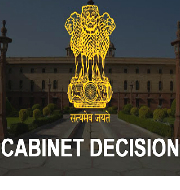Green Revolution-Krishonnati Yojana: CCEA approves continuation of Umbrella Scheme in agriculture sector
Cabinet Committee on Economic Affairs (CCEA) has approved continuation of Umbrella Scheme, Green Revolution – Krishonnati Yojana in agriculture sector beyond 12th Five Year Plan from 2017-18 to 2019-20. The Umbrella scheme comprises of 11 Schemes and Missions.
Key Facts
The 11 schemes and missions were clubbed together under one umbrella scheme ‘Green Revolution – Krishonnati Yojana in 2017-18. They aim to develop agriculture and allied sector in holistic and scientific manner to increase income of farmers by enhancing production, productivity and better returns on produce. They primarily focus on creating and strengthening of infrastructure of production, reducing production cost and marketing of agriculture and allied produce. These schemes will be now continued for three financial years, i.e., 2017-18, 2018-19 and 2019-20 with an expenditure of Rs.33,269 crore.
Schemes part of Green Revolution-Krishonnati Yojana
Mission for Integrated Development of Horticulture (MIDH): It aims to promote holistic growth of horticulture sector and also enhance horticulture production, improve nutritional security and income support tofarm Households.
National Food Security Mission (NFSM): It aims to increase production of rice, wheat, pulses, coarse cereals and commercial crops, through area expansion and productivity enhancement in suitable manner in identified districts of country. It will also restore soil fertility and productivity at individual farm level and enhance farm level economy. It also includes National Mission on Oil Seeds and Oil Palm (NMOOP) which aims to augment availability of vegetable oils and to reduce the import of edible oils.
National Mission for Sustainable Agriculture (NMSA): It aims at promoting sustainable agriculture practices best suitable to specific agro-ecology focusing on integrated farming, appropriate soil health management and synergizing resource conservation technology.
Submission on Agriculture Extension (SMAE): It aims to strengthen ongoing extension mechanism of State Governments, local bodies etc. in achieving food and nutritional security and socio-economic empowerment of farmers. It also seeks to institutionalize programme planning and implementation mechanism, forge effective linkages and synergy amongst various stake-holders, support HRD interventions, promote pervasive and innovative use of electronic and print media, inter-personal communication and ICT tools, etc.
Sub-Mission on Seeds and Planting Material (SMSP): It aims to increase production of certified and quality seed to increase SRR and upgrade the quality of farm saved seeds. Under it, seed multiplication chain will be strengthen and also new technologies and methodologies in seed production, processing, testing etc. will be promoted to strengthen and modernizing infrastructure for seed production, storage, certification and quality etc.
Sub-Mission on Agricultural Mechanisation (SMAM): It aims to increase reach of farm mechanization to small and marginal farmers and to regions where availability of farm power is low. Under it, ustom Hiring Centres to offset adverse economies of scale arising due to small landholding and high cost of individual ownership will be promoted. Hubs for hi-tech and high value farm equipment, create awareness among stakeholders through demonstration and capacity building activities will be also created under it.
Sub Mission on Plant Protection and Plan Quarantine (SMPPQ): It aims to minimize loss to quality and yield of agricultural crops from ravages of diseases, insect pests, nematodes, weeds, rodents, etc. and shield agricultural bio-security from incursions and spread of alien species. It will also facilitate exports of Indian agricultural commodities to global markets and promote good agricultural practices, particularly with respect to plant protection strategies and strategies.
Integrated Scheme on Agriculture Census, Economics and Statistics (ISACES): It aims to undertake agriculture census, study of cost of cultivation of principal crops and undertake research studies on agro-economic problems of the country.
Integrated Scheme on Agricultural Cooperation (ISAC): It aims to provide financial assistance for improving the economic conditions of cooperatives, remove regional imbalances and speed up cooperative development in agricultural marketing, computerization, processing, storage and weaker section programmes. It also will help cotton growers fetch remunerative price for their produce through value addition besides ensuring supply of quality yarn at reasonable rates to decentralized weavers.
Integrated Scheme on Agricultural Marketing (ISAM): It aims to develop agricultural marketing infrastructure and promote innovative and latest technologies and competitive alternatives in agriculture marketing infrastructure. It also seeks to provide infrastructure facilities for grading, standardization and quality certification of agricultural produce. Under it nationwide marketing information network will be established to integrate markets through common online market platform to facilitate pan-India trade in agricultural commodities, etc.
National e-Governance Plan (NeGP-A): It aims to bring farmer centricity and service orientation to programmes. Under it reach & impact of extension services will be enhanced and access of farmers to information &services throughout crop-cycle will be improved. It will also enhance and integrate existing ICT initiatives of Centre and States and also enhance efficiency and effectiveness of programs through making available timely and relevant information to farmers for increasing their agriculture productivity.
Month: Current Affairs - May, 2018
4 Comments
Leave a Reply
You must be logged in to post a comment.



kumar sahil
May 7, 2018 at 10:24 amnice work
kumar sahil
May 7, 2018 at 10:24 amnice work
kumar sahil
May 7, 2018 at 10:26 amnice current affair
kumar sahil
May 7, 2018 at 10:26 amnice current affair